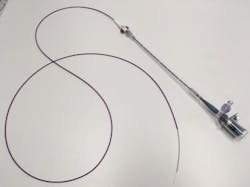Cardiac catheter pairs light, ultrasound to measure plaques
A team of researchers at the University of California - Davis (UC Davis) has combined intravascular ultrasound (IVUS) with fluorescence lifetime imaging (FLIm) in a single catheter probe that can image the tiny arteries of a living heart. The new catheter can simultaneously retrieve structural and biochemical information about arterial plaque, with the goal of being able to more reliably predict heart attacks.
Related: Fluorescence 'lifetime' moves toward clinical application
Developed in Professor Laura Marcu's lab in the Department of Biomedical Engineering at UC Davis, the catheter features an optical fiber that sends short laser pulses into surrounding tissue, which fluoresces with tiny flashes of light in return. Different kinds of tissue (collagen, proteins, lipids) emit different amounts of fluorescence. At the same time, an ultrasound probe in the catheter records structural information about the blood vessel.
The combination FLIm-IVUS imaging catheter provides a comprehensive insight into how atherosclerotic plaque forms, aiding diagnosis and providing a way to measure how plaques shrink in response to therapy.
The catheter, which has been tested in living swine hearts and samples of human coronary arteries, is flexible enough to access coronary arteries in a living human following standard procedures. It does not require any injected fluorescent tracers or any special modification of the catheterization procedures.
The new technique could not only can improve understanding of mechanisms behind plaque rupture—an event with fatal consequences—but also the diagnosis and treatment of patients with heart disease.
Marcu's group is currently working to obtain FDA approval to test this new intravascular technology on human patients.
Full details of the work appear in the journal Scientific Reports.

